

SR-1
(1959) The SR-2 was a remarkable camera at the time, but it was also financially far beyond the reach of the average shutterbug. It retailed at $250 in the US which was much more than most photographers wanted to spend . That's nearly $3,000 in today's dollars -- adjusting for inflation. Sure, it was worth it, but most people couldn't afford such a luxury, especially because there were plenty of other, high-quality, 35mm SLR cameras available at substantially lower cost. You could get an Asahi Pentax S SLR for $195 or a German Contaflex I for a mere $150. These facts didn't help sales of the SR-2 -- at a time when rumors circulated that those "cheap Jap lenses" were filled with water -- even though the SR-2 was a far superior product. So Minolta looked for creative ways to meet the photographic demand that the SR-2 had generated.
In order to market their new SLR design to a wider audience, Minolta produced the SR-1 in 1959. It was a less expensive version of the SR-2 -- with fewer features. To save production costs, Minolta dropped the top speed of the SR-1 to 1/500, which was more than adequate for most photographic situations (the film speeds at the time were much slower than they are today). In addition, the SR-1 was marketed with a slower, less expensive lens. Instead of the fast, 55mm f1.8 Auto Rokkor lens sold with the SR-2, Minolta packaged the SR-1 with a new, 55mm f2.0 Auto Rokkor. That doesn't sound like a big difference, but it retained the semi-auto-diaphragm feature of the SR-2 and saved production cost with a slower f2.0 aperture. Of course, one could purchase the faster f1.8 55mm lens with the camera instead of the f2.0 55mm, if interested. The SR-1 also retained the other highly desirable feature of the SR-2 -- the instant return mirror.
With the 55mm lens, the SR-1 sold at a 30% savings relative to the
SR-2 -- only $175. So the consumer could buy
the SR-1 at a substantial saving -- and hardly notice a difference in features.
This was still very expensive at the time, but it was a deciding factor
in keeping Minolta competitive in a very fluid market. By 1959, just
one year after the introduction of the Minolta SR-2,
other well-respected Japanese SLR cameras were making their debut -- the
Beseler Topcon ($195), the Canonflex ($295), the Heiland Pentax H-2 ($180),
the Miranda C ($280), the Nikon F ($330), and the Petri Penta ($150) -- just
to name a few. Minolta marketed the SR-1 just in the nick of time,
and was able to keep its head above the turbulent SLR waters.
The SR-1 lasted from 1959 to 1971, and was one of Minolta's longest-lasting
models. But there were actually several changes to the SR-1 between 1959
and 1971, with gradual variations over time. MINMAN has grouped these SR-1
variations into "models" based on the features that we feel are most significant.
Keep in mind that these categories were decided on by MINMAN and are
not any official designation by Minolta -- or anyone else. Other web
sites will only list one version of the SR-1, and some will group the various
models differently. Except for the SR-1s, these model numbers are not
inscribed on the cameras.

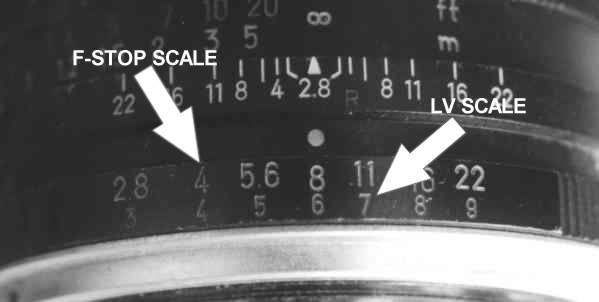
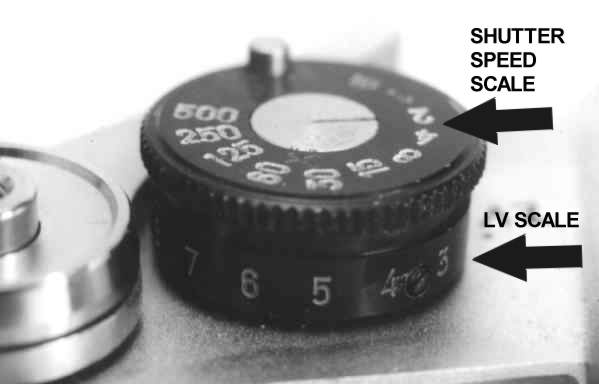


But this changed when Minolta introduced the
SR-3 and
SR-1 (model c)
which were designed for fully-automatic aperture operation. These camera
automatically reset the lens to full aperture immediately after each exposure
-- without advancing the film -- and the old mechanisms proved inadequate
to the task. An important change had to be made to the Auto-Rokkor
lenses at this time. To allow the new cameras to instantly re-open
the aperture in the lens after the exposure, it was necessary for Minolta
to modify the aperture linkage in the original Auto-Rokkor lenses. (The Rokkor
lenses didn't require any change since they lacked the aperture linkage.)
Specifically, the original Auto-Rokkor lenses have their aperture linkage
on a rotating, external plate on the back of the lens. This approach
proved inadequate to handle the speed of a fully-automatic aperture, and
Minolta modified the mechanism to an internal, lateral-operating pin.
On the original Auto-Rokkor lenses (those with the rotating external plate),
the aperture linkage moved up and down as it rotated. This required
a fairly tall lever inside the camera body -- to make sure that the two would
always engage as the pin in the lens moved up and down, and the pin in the
camera moved left and right. It also required a fair amount of pressure
and lateral movement from the lever in the camera to open the lens up. The
drawback is that the original Auto-Rokkor lenses will not operate at all
f-stops on later cameras. You'll be able to select any f-stop on the
lens, but when the older lens stops down, the aperture will stop at around
f8. For example, let's say you dial in f16 on the aperture ring.
When the exposure is taken, the lens will only stop down to f8 and
the picture will be over-exposed by two f-stops. These older lenses
were designed for cameras with tall aperture pins and when used on newer
cameras, at higher apertures, the tab in the lens is not fully released.
While this will not cause damage to the lens or camera, it prevents
the smallest f-stops settings from being used.
The SR-1 (model c) was available in chrome or black.
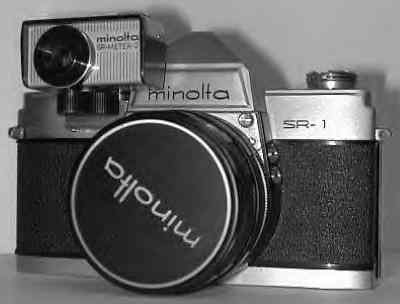
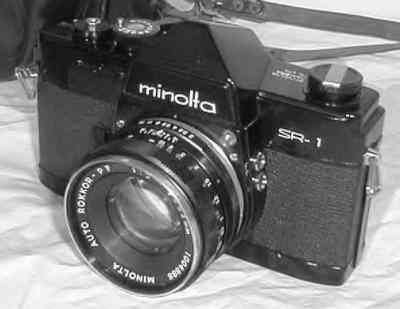

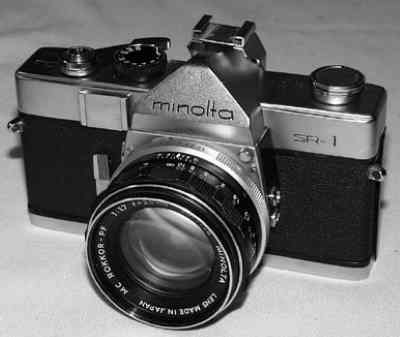
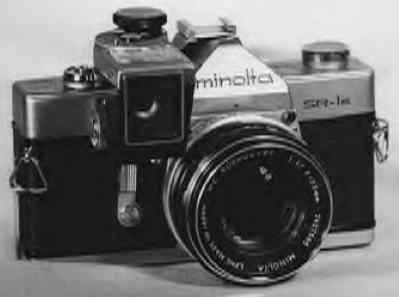
The SR-1 was one of Minolta longest-lasting camera models -- from 1959 to 1971 -- 12 years! It was an essential ingredient in making Minolta a world-wide player in the photographic community. Without the lower-priced SR-1, Minolta would not have been able to reach as many photographers as it did. The "Minolta" name would have been less well-known, and it's history would have been completely different. But the SR-1 introduced a sea of photographers to the wonders of SLR photography, and helped change the way that we take pictures today. The SR-1 was lovingly retired in 1971 with the release of Minolta's new SRT100 -- an amalgamation of the of SR-1 and the SRT101. So in some ways the SR-1 lived on for many more years.
For a comparative look at the major features of the various SR-1 models, check out MINMAN's SLR table -- the world's most complete!
| Camera | SR-1 | SR-1 | SR-1 | SR-1 | SR-1 | SR-1 | SR-1s |
| Model | a | b | c | d | e | V | s |
| Years made | 1959-1960 | 1960-1961 | 1961-1962 | 1962-1963 | 1963-1965 | 1965-1967 | 1967-1971 |
| Type | Mechanical 35mm SLR | Mechanical 35mm SLR | Mechanical 35mm SLR | Mechanical 35mm SLR | Mechanical 35mm SLR | Mechanical 35mm SLR | Mechanical 35mm SLR |
| Shutter | Fully mechanical, horizontal, cloth focal plane shutter | Fully mechanical, horizontal, cloth focal plane shutter | Fully mechanical, horizontal, cloth focal plane shutter | Fully mechanical, horizontal, cloth focal plane shutter | Fully mechanical, horizontal, cloth focal plane shutter | Fully mechanical, horizontal, cloth focal plane shutter | Fully mechanical, horizontal, cloth focal plane shutter |
| Metering | None | None | None | Clip-on | Clip-on | Clip-on | Clip-on |
| Meter sensitivity | -- | -- | -- | Depends on clip-on meter | Depends on clip-on meter | Depends on clip-on meter | Depends on clip-on meter |
| Exposure modes | Manual | Manual | Manual | Manual Metered manual with clip-on meter |
Manual Metered manual with clip-on meter |
Manual Metered manual with clip-on meter |
Manual Metered manual with clip-on meter |
| Automatic exposure adjustment |
-- | -- | -- | -- | -- | -- | -- |
| Viewfinder | Fixed eye-level pentaprism | Fixed eye-level pentaprism | Fixed eye-level pentaprism | Fixed eye-level pentaprism | Fixed eye-level pentaprism | Fixed eye-level pentaprism | Fixed eye-level pentaprism |
| Focusing screen | Fresnel-field screen with a micro-prism center | Fresnel-field screen with a micro-prism center | Fresnel-field screen with a micro-prism center | Fresnel-field screen with a micro-prism center | Fresnel-field screen with a micro-prism center | Fresnel-field screen with a micro-prism center | Fresnel-field screen with a micro-prism center |
| Lens mount | Minolta SLR bayonet Semi-automatic diaphragm |
Minolta SLR bayonet Semi-automatic diaphragm |
Minolta SLR bayonet Automatic diaphragm |
Minolta SLR bayonet Automatic diaphragm |
Minolta SLR bayonet Automatic diaphragm |
Minolta SLR bayonet Automatic diaphragm |
Minolta SLR bayonet Automatic diaphragm |
| Lenses | Optimum: early
Auto Rokkor Usable: later Auto Rokkor, Rokkor, MC Rokkor, MC Rokkor-X, MC Celtic, MD Rokkor, MD Celtic, MD Minolta |
Optimum: early
Auto Rokkor Usable: later Auto Rokkor, Rokkor, MC Rokkor, MC Rokkor-X, MC Celtic, MD Rokkor, MD Celtic, MD Minolta |
Optimum: later
Auto Rokkor Usable: early Auto Rokkor, Rokkor, MC Rokkor, MC Rokkor-X, MC Celtic, MD Rokkor, MD Celtic, MD Minolta |
Optimum: later
Auto Rokkor Usable: early Auto Rokkor, Rokkor, MC Rokkor, MC Rokkor-X, MC Celtic, MD Rokkor, MD Celtic, MD Minolta |
Optimum: later
Auto Rokkor Usable: early Auto Rokkor, Rokkor, MC Rokkor, MC Rokkor-X, MC Celtic, MD Rokkor, MD Celtic, MD Minolta |
Optimum: later
Auto Rokkor Usable: early Auto Rokkor, Rokkor, MC Rokkor, MC Rokkor-X, MC Celtic, MD Rokkor, MD Celtic, MD Minolta |
Optimum: later
Auto Rokkor Usable: early Auto Rokkor, Rokkor, MC Rokkor, MC Rokkor-X, MC Celtic, MD Rokkor, MD Celtic, MD Minolta |
| Mirror | Instant return mirror | Instant return mirror | Instant return mirror | Instant return mirror | Instant return, over-sized mirror | Instant return, over-sized mirror | Instant return, over-sized mirror |
| Film speeds | -- | -- | -- | Depends on meter | Depends on meter | Depends on meter | Depends on meter |
| Shutter speeds | Mechanical: 1 - 500; B Manual: 1 - 500; B |
Mechanical: 1 - 500; B Manual: 1 - 500; B |
Mechanical: 1 - 500; B Manual: 1 - 500; B |
Mechanical: 1 - 500; B Manual: 1 - 500; B |
Mechanical: 1 - 500; B Manual: 1 - 500; B |
Mechanical: 1 - 500; B Manual: 1 - 500; B |
Mechanical: 1 - 1,000; B Manual: 1 - 1,000; B |
| Flash synch | X: B; 1 - 1/45 FP: B; 1 - 1/15 M: B; 1 - 1/15 MF: B; 1 - 1/15 |
X: B; 1 - 1/45 FP: B; 1 - 1/15 M: B; 1 - 1/15 MF: B; 1 - 1/15 |
X: B; 1 - 1/45 FP: B; 1 - 1/15 M: B; 1 - 1/15 MF: B; 1 - 1/15 |
X: B; 1 - 1/45 FP: B; 1 - 1/15 M: B; 1 - 1/15 MF: B; 1 - 1/15 |
X: B; 1 - 1/45 FP: B; 1 - 1/15 M: B; 1 - 1/15 MF: B; 1 - 1/15 |
X: B; 1 - 1/60 FP: B; 1 - 1/15 M: B; 1 - 1/15 MF: B; 1 - 1/15 |
X: B; 1 - 1/60 FP: B; 1 - 1/15 M: B; 1 - 1/15 MF: B; 1 - 1/15 |
| Flash connection | Clip-on, cold shoe X and FP PC contacts |
Clip-on, cold shoe X and FP PC contacts |
Clip-on, cold shoe X and FP PC contacts |
Clip-on, cold shoe X and FP PC contacts |
Clip-on, cold shoe X and FP PC contacts |
Clip-on, cold shoe X and FP PC contacts |
Clip-on, cold shoe X and FP PC contacts |
| Film counter | Automatically resetting type counting upward | Automatically resetting type counting upward | Automatically resetting type counting upward | Automatically resetting type counting upward | Automatically resetting type counting upward | Automatically resetting type counting upward | Automatically resetting type counting upward |
| Battery | -- | -- | -- | -- | -- | -- | -- |
| Stop-down DOF button |
No | No | No | No | No | No | No |
| Film Back | Non-interchangeable | Non-interchangeable | Non-interchangeable | Non-interchangeable | Non-interchangeable | Non-interchangeable | Non-interchangeable |
| Multiple exposures | No | No | No | No | No | No | No |
| Film advance | Lever type | Lever type | Lever type | Lever type | Lever type | Lever type | Lever type |
| Self-timer | Mechanical, over-rideable, non-cancellable, adjustable from 4 to 10 seconds | Mechanical, over-rideable, non-cancellable, adjustable from 4 to 10 seconds | Mechanical, over-rideable, non-cancellable, adjustable from 4 to 10 seconds | Mechanical, over-rideable, non-cancellable, adjustable from 4 to 10 seconds | Mechanical, over-rideable, non-cancellable, adjustable from 4 to 10 seconds | Mechanical, over-rideable, non-cancellable, adjustable from 4 to 10 seconds | Mechanical, over-rideable, non-cancellable, adjustable from 4 to 10 seconds |
| Film reminder | No | No | No | No | No | No | No |
| Other | Cable release connection, tripod socket | Cable release connection, tripod socket | Cable release connection, tripod socket | Cable release connection, tripod socket | Cable release connection, tripod socket | Cable release connection, tripod socket | Cable release connection, tripod socket |
| Body size | 2 x 3 1/2 x 5 3/4 inches | 2 x 3 1/2 x 5 3/4 inches | 2 x 3 1/2 x 5 3/4 inches | 2 x 3 1/2 x 5 3/4 inches | 2 x 3 1/2 x 5 3/4 inches | 2 x 3 1/2 x 5 3/4 inches | 2 x 3 1/2 x 5 3/4 inches |
| Body weight | One pound two ounces | One pound two ounces | One pound two ounces | One pound two ounces | One pound two ounces | One pound two ounces | One pound two ounces |
RETURN TO THE MANUAL MINOLTA HOME PAGE
We didn't want to do this, but since other websites have been stealing our
stuff, we have no alternative but to state:
COPYRIGHT@1995-2023 by
Joe McGloin.
All Rights Reserved. The material on this website is protected by US Federal
copyright laws. It cannot be copied or used in any manner without specific
approval from the owner.